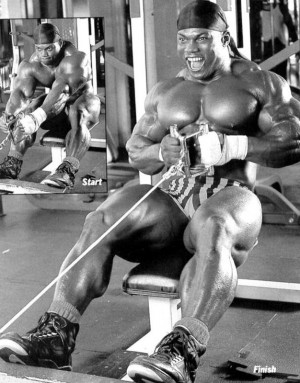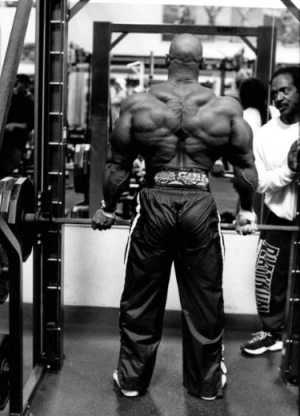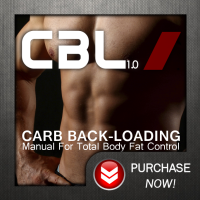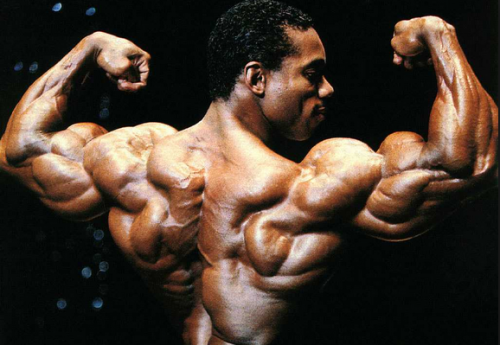By Monte Spicer
Bodybuilding is dead. The sport is still around, and people still compete, but the atmosphere around the game isn’t even close to what it used to be—and it never will be again. When I talk about training atmosphere, my frame of reference from my bodybuilding career is the time I spent at Gold’s Gym back in the 1990’s when it still really was the Mecca of Bodybuilding. That’s where I learned the meaning of good, hard, intelligent training from the absolute best in the business.
Every two weeks or so back then, I’d drive from the San Francisco Bay Area down to Los Angeles to train at Gold’s. I’d make the trip south on Friday, train on Saturday and Sunday, go to the Firehouse with the training crowd—and eat a stack of buckwheat pancakes, some yams, and the bodybuilder’s breakfast—then drive almost three hours back up north. Sometimes I’d just spend one day there, depending on my schedule. Other times, the crowd would be at Powerhouse in Fullerton—down in Orange County—so I’d go there and we’d do the same things.
The Venice Experience
The first time I ever went to Gold’s, the first guy I saw was Vic Richards. If you don’t know who he was, search Google for some images. Vic was a giant African guy with 35-inch quads—and I first met him back when guys used to wear tights to the gym. That initial day, he was wearing little white spandex tights, and his legs had veins that looked like water hoses coming right through them.
Training in Venice was like the part of a roller coaster ride where you’re still going up, anticipating something amazing. I was excited as hell to be training with the best of the best. Everyone who was anyone in bodybuilding trained there, and this included some all-time greats who, although they weren’t competing anymore, still trained hard and dished out advice to anyone who asked.
It’s hard to explain the energy level at Gold’s to anyone who’s never been there. Training next to professionals—and with them—takes everything you do to another level. You’d also see guys who didn’t compete at all, but trained harder than the pros, and that would motivate me even more. The best part? People there were friendly. Everyone would leave their ego at the door and put all of their energy into training.
Going into that world brought intensity out of me and made me focus on what was important. That focus came from seeing how the best in the world were training, how they lasered in on what they were doing, and how they prepared to train. These guys didn’t talk. They just trained. You could ask them questions, and they’d give you the answers you needed, but training was everything. We had Flex Wheeler, Chris Cormier, and Shawn Ray—and Kevin Levrone would come in from Maryland just to be there. That did nothing but make me work harder.
Muscle Stimulation
 The overriding factor with these guys was the idea of stimulating muscle to encourage growth—and not just annihilating it. When you train this way, there’s no wasted movement. You have to think of your muscles as balloons. With every rep, you’re getting oxygen to your muscle fibers and blowing them up. The muscle expands until it feels like it’s going to explode. That’s how you get your mind and your muscles linked up and in combination.
The overriding factor with these guys was the idea of stimulating muscle to encourage growth—and not just annihilating it. When you train this way, there’s no wasted movement. You have to think of your muscles as balloons. With every rep, you’re getting oxygen to your muscle fibers and blowing them up. The muscle expands until it feels like it’s going to explode. That’s how you get your mind and your muscles linked up and in combination.
I learned that you can’t accomplish this kind of stimulation just by throwing weights around. Most guys are so concerned about the poundages they’re moving that they don’t do anything to really encourage the level of stimulation they need. As a result, they never see change, their joints always hurt, and they’re always injured. That’s the most important thing I learned in Venice—with training, stimulation is everything.
Simulating the Mecca
After spending two days in Venice, the idea was to bring all of this back to the Bay Area with me. It would carry over for a couple of weeks, but I’d eventually have to go back and reharge my batteries at the Mecca. There was no substitute for training alongside the best in the world. The only way I ever came close to reproducing the feel I had in Venice was with the right training partners. You have to have good ones. At Gold’s, we used to call them “sparring partners,” because that’s exactly what a training partner is when you’re working hard enough.
To find one of these, you have to hook up with somebody who can push you and motivate you. They have to have something to offer in this regard, because you’ll be wasting your time if they don’t. They don’t necessarily have to compete, either. Some of the best guys I’ve ever trained with didn’t compete, but they had hearts like lions and just loved to train. I trained for years with a national competitor named Raoul Fulcher, and he was the strongest guy I’ve ever seen in my life. Raoul could squat with five plates on each side for 50 reps—or, he’d lunge with that weight for ten reps, then squat with it for ten, talking shit the entire time he was doing it.
Training with a great partner can’t do anything but make you better. Other than Raoul, the only training partner I’ve ever had who could hang has been my business partner, Tammy Marquez, who’s also a successful bodybuilder in her own right. Find the right sparring partner, train in a gym that fits you, and recreate that brand of intensity that’s not corporate and watered-down. That’s the recipe for success.
Wistful Thinking
I don’t really miss competing, but I miss training the way I did in Venice, so that’s the environment I’ve tried to create in my own gym (Kinetic Chain Sport in Pleasanton, CA). I’ve tried to turn it into a little Venice.
The problem now is that people don’t want to train like that anymore. They’ll say they do, but they’ll go to these commercial gyms just to be seen—that whole, “Look at me! Look what I’m wearing!” culture. Back then, the best guys in the world came to the gym looking like a bag of Skittles. Your clothes didn’t even have to match. Now, everybody comes in looking fashionable and smelling good, and they leave looking the same way they did last year. That’s not training.
The Workouts
 I didn’t want to waste my trips down to Venice doing anything stupid, so I’d train the big body parts—my legs and back—while I was there. These workouts were insane—I’m talking about having throw-up buckets and sponges set up next to where we’d lift, because we’d make a point of pushing each other hard enough to need them. One important thing to note is that we usually only trained for 45-60 minutes. That’s all you really need, because after that, your intensity and focus will drop.
I didn’t want to waste my trips down to Venice doing anything stupid, so I’d train the big body parts—my legs and back—while I was there. These workouts were insane—I’m talking about having throw-up buckets and sponges set up next to where we’d lift, because we’d make a point of pushing each other hard enough to need them. One important thing to note is that we usually only trained for 45-60 minutes. That’s all you really need, because after that, your intensity and focus will drop.
Going in, we never knew exactly what we’d be doing. We trained instinctively, with the focus on bringing up our weak points and gearing our workouts to our lagging body parts. Most times, we’d figure this out on your own, but occasionally I’d talk to Charles Glass and have him show me how to change my angles and do certain things differently. Charles was a great resource, and he’s definitely something very special.
Legs
Leg Extensions: 3 sets of 100 reps with 60 pounds.
Prone Hamstring Curls: These were done as a warm-up, just to get some blood into the hamstrings.
Squats: We trained these instinctively, increasing reps and weight to stimulate the muscles for growth.
Close Stance Hack Squats: We did these the same way we did squats—just loading it up and rolling.
Back
The main idea for us here was balance. We wanted a little bit of everything, so no matter what we did, we’d vary the order with every workout. Sometimes we’d start from the top. Other times, we’d start from the bottom and reverse the order, or we’d start in the middle and go down or up.
Pull-ups: Again, we’d be very instinctive here, working all sorts of variations—to the front and back, wide-grip and narrow.
T-Bar Rows: We’d do these for the lower lats, but using quarters, not 45 pound plates. This lets you pull closer to your chest, giving you more of a stretch and more of a squeeze when you come up.
Barbell Bent Rows: Tons of them with various grips.








Recent Comments